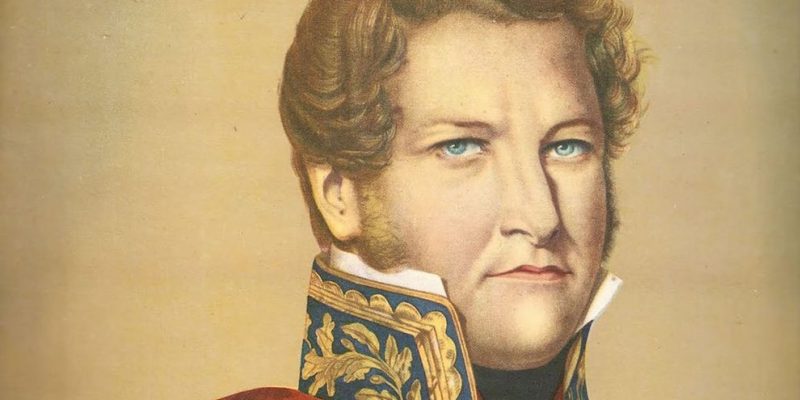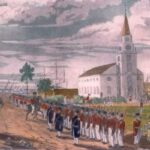We explain what caudillismo is, its causes, consequences and other characteristics. Also, differences between leader and dictator.

What is caudillismo?
Caudillismo is a political and social trend, especially Latin American, which consists of the authoritarian and personalistic exercise of power by a leader or strong man. This leader, called leader (from Latin capitellum“little head”), achieves the support of his followers through prestige or charisma and has control of an armed group.
Caudillos usually rule over a given territory, sometimes as regional leaders who challenge a central power or other political projects, and sometimes as top heads of state. For this, establish a paternalistic relationship with their supporters and subordinates and they subject all institutions to their personal will, under the premise that they know what is best for society.
Latin American caudilloism emerged in the 19th century after the wars that allowed the colonial territories to achieve independence from Spain. At that time, the young Latin American nations began to take their first steps towards the formation of republican regimes.
The regional leaders, many of them former heroes of the independence wars and belonging to the landowning classes, occupied the power vacuum generated by the collapse of the colonial order. They rivaled or put pressure on democratically elected governments, thus maintaining important influence in politics. Some leaders even served as governors of provinces or became president of the country.
What distinguishes caudillismo from dictatorships is that The leader usually bases his authority on his charisma or popularity among broad sectors of the population, which allows it to gain a certain legitimacy, while the dictatorship is an authoritarian regime that may or may not be established by a charismatic leader. Even so, the leader may lose the support and loyalty of his followers, which may benefit another leader willing to overthrow the previous one.
Although some authors reserve the term “caudillismo” for the 19th century, Others also use it to characterize some charismatic and authoritarian leaders of the 20th century mainly from Latin America but also from other countries. In some cases, the leaders themselves called themselves “caudillos,” such as Francisco Franco in Spain since the 1930s. In addition, some historians use the term for other historical experiences, especially for contexts of institutional crisis and governments led by military leaders, such as shogunate from Japanese history or the warlord era in China.
Key points
- Caudillismo is a Latin American political trend in which an authoritarian leader, called a caudillo, exercises power in a personal manner through charisma and military control.
- It emerged after the independence wars of the 19th century, when the collapse of the colonial order facilitated the rise of military leaders in a context of institutional instability.
- Some historians use the term “caudillo” to also refer to some political and military leaders of the 20th century in Latin America and Spain.
- Caudillismo is not synonymous with dictatorship but it can lead to the formation of dictatorial governments, although it can also coexist with some democratic institutions.
- See also: Authoritarianism
Characteristics of caudillismo
Caudillismo has the following characteristics:
- It implies the concentration of political power in one figure: the caudillo. He usually exercises power in an authoritarian and top-down manner, and is generally based on his military skills and the loyalty of his followers and supporters.
- The caudillo's government is usually not democratic, but is based on the persecution of dissent although it usually has popular support (at least for a time), since the will of the leader is trusted to lead the nation or district towards a better destiny.
- The leader, in some cases, can coexist with democratic institutions and other instances of political organization, but their personal will is above the institutions and ends up imposing itself.
- Caudillos usually come to power through force and they are maintained through the same mechanism and with the political support of their supporters, until another leader gains greater influence over the troops or the population and manages to overthrow him, or when another political faction defeats him militarily.
Causes of caudillismo
The causes of the appearance of caudillism were:
- The end of the independence wars which by dismantling the colonial order caused a power vacuum characterized by civil or internal wars in which the leaders emerged. These had the ability to recruit and command troops, protect their supporters and lead or support one of the opposing factions.
- The formation of unstable or inefficient democratic republics who were unable to gain the trust of the majority of the population or exercise true control over the military forces.
- The appearance of periods of crisis or socioeconomic and institutional instability that the political confrontations could not be resolved and that caused the political rise of the leaders, who managed to satisfy some local needs or presented themselves as a solution to national-scale problems.
- The landowning origin of many leaders, or the support they received from other property-owning sectors which gave them the resources to gain the loyalty of the troops and other military leaders, above subordination to a central and republican government.
Consequences of caudillism
The most frequent consequences of caudillismo were:
- The concentration of political and economic power in the leader and his lieutenants which weakened the institutions of democracy and often led to the establishment of dictatorships.
- The enrichment of the leader and his closest supporters and the marginalization, exile or even impoverishment of his detractors, which made it especially difficult to oppose the leader or remove him from power. However, many leaders distributed goods among the lower classes to maintain their support.
- The reinforcement of regionalisms and local identities especially where there were powerful leaders, which made the work of consolidating a stable and organized nation particularly difficult.
- The legacy of a despotic and personalist way of exercising political power. This has its heritage in the way some political leaders conceive today or even in some doctrines that emphasize the paternalistic role of the State.
Leader and dictator
Although caudillismo and dictatorship are close concepts, especially because A leader who enters the government can establish a dictatorship characterized by political repression and the loss of freedoms, both terms are used in a different sense.
On the one hand, because caudillismo always implies the existence of a caudillo, that is, a charismatic leader of military origin, who exercises power in an authoritarian and personalistic manner. While dictatorships may or may not be headed by a charismatic leader such as military and civil-military dictatorships (in which there may or may not be a leader, and in which the government may be exercised by a military junta) or communist dictatorships (in which there is a one-party and bureaucratized State).
On the other hand, because although they tend to be authoritarian, caudillo governments can remain on the border between democracy and dictatorship by supporting certain democratic institutions that offer them legitimacy.
- Dictatorship
Examples of leaders

Some leaders of Latin America and Spain in the 19th and 20th centuries were:
- Juan Manuel de Rosas (1793-1877). He was an Argentine military man, politician and rancher, governor of the province of Buenos Aires on two occasions (1829-1832 and 1835-1852) and main leader of the then called Argentine Confederation. Since 1835 he governed with the “sum of public power”, which is why he concentrated political decisions and persecuted the opposition. In addition to his authoritarian character, he stood out for his charisma and his personal relationship with peons and other subordinate leaders. He resigned after being defeated in the Battle of Caseros in 1852, which brought the Santa Fe leader Justo José de Urquiza to power. The period between 1829 and 1852 is called the time of Rosas.
- Juan Facundo Quiroga (1788-1835). He was an Argentine politician and military man, known as “the Tiger of the Llanos,” and one of the most important federal leaders during the civil wars after the declaration of independence. He stood out for his skill as a military leader and for his charisma among his subordinates. He was governor of the province of La Rioja and was in favor of a Constitution that organized the nation, compared to the position of other leaders such as Juan Manuel de Rosas. He was killed in an ambush in 1835.
- José Tomás Boves (1782-1814). He was a soldier and leader of Spanish origin, known as “the Lion of the Llanos.” He stood out as commander of the royalist army during the Venezuelan war of independence, taking advantage of the resentment of the llaneros (mostly mestizo groups of the lower classes of the Llanos region) against the elites of the time, and took up arms against the Second Venezuelan Republic (1813-1814). He managed to defeat Simón Bolívar's liberating army in some battles, but he died wounded by a spear in 1814. After his death, the royalist cause lost popularity among the llaneros.
- Antonio López de Santa Anna (1795-1876). He was a Mexican soldier and politician, who initially fought the insurgents fighting for independence but later joined the Trigarante Army that achieved emancipation in 1821. His charisma and the support of loyal troops allowed him to exercise great influence in Mexican politics. for half a century. He was the architect of several pronouncements and insurrections and held the presidency in various periods, the last of them in a dictatorial manner (1853-1855), when he called himself “His Serene Highness”, until he was overthrown.
- Francisco “Pancho” Villa (1878-1923). He was one of the military leaders of the Mexican Revolution, known as the “Centaur of the North.” He was part of the events that put an end to the Porfiriato (the authoritarian regime of Porfirio Díaz) and had a decisive participation in the overthrow of President Victoriano Huerta, who had usurped the presidency in 1913. During the revolution, he commanded the Northern Division and was provisional governor of Chihuahua. Although he held this position for a brief period, he maintained his authority as a leader throughout time and some of his troops were loyal to him until the end of his life. He was murdered in 1923.
- Emiliano Zapata (1879-1919). He was a Mexican peasant and revolutionary, and one of the most important leaders of the Mexican Revolution. He was commander of the Liberation Army of the South, which is why he was nicknamed “the Caudillo of the South.” Under his command, various social demands were fought for, such as the distribution of land among peasants and a more participatory democracy, and especially against the latifundia tradition inherited from the Porfiriato. He faced the constitutionalist side led by Venustiano Carranza and was assassinated in 1919.
- Francisco Franco (1892-1975). He was a Spanish soldier, leader of the nationalist side during the Spanish civil war (1936-1939). He was head of the Spanish State and headed a dictatorship from the end of the civil war until his death in 1975. Although he was not a caudillo in the manner of Latin America in the 19th century, he called himself “the Caudillo of Spain,” or simply “the Caudillo”, in a similar way to how Benito Mussolini called himself “Duce” in Italy or Adolf Hitler “Führer” in Germany.
References
- De Riz, L. (2015). Caudilloism. Encyclopedia Britannica. https://www.britannica.com/
- Legal Encyclopedia. (sf). Caudilloism. Legal Encyclopedia. http://www.enciclopedia-juridica.com/
- Goldman, N. and Salvatore, R. (Comps.). (1998). Rio de la Plata caudillismos. New looks at an old problem. Eudeba.
- Krauze, E. (2021). Century of leaders. Political biography of Mexico (1810-1910). Tusquets.
- Pinto Vallejos, J. (2022). Leaders and commoners. The social construction of the state in South America (Argentina, Peru, Chile, 1830-1860). LOM-Prometheus.





